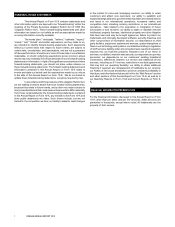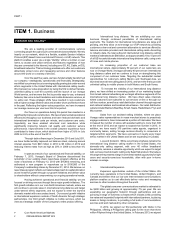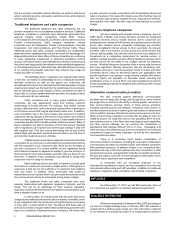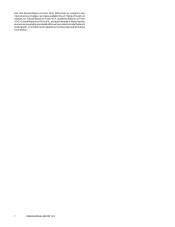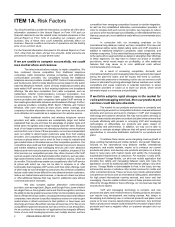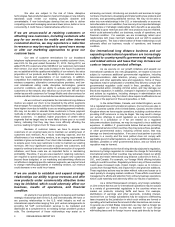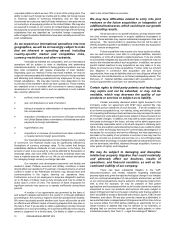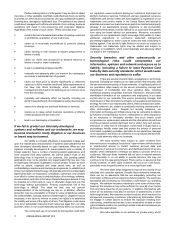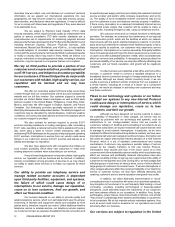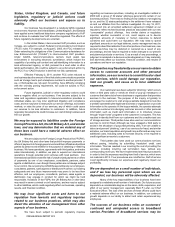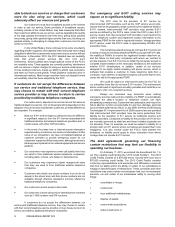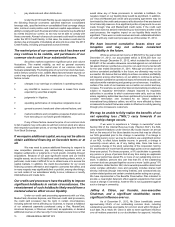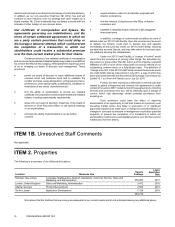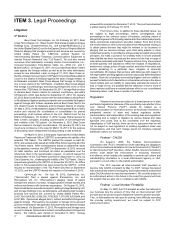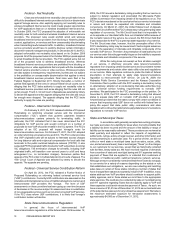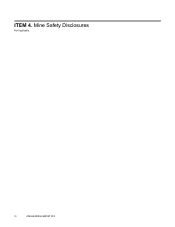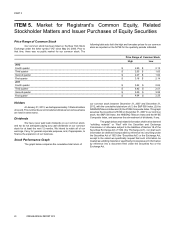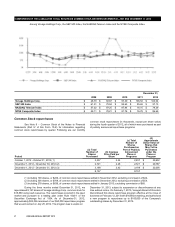Vonage 2012 Annual Report Download - page 17
Download and view the complete annual report
Please find page 17 of the 2012 Vonage annual report below. You can navigate through the pages in the report by either clicking on the pages listed below, or by using the keyword search tool below to find specific information within the annual report.11 VONAGE ANNUAL REPORT 2012
Parties making claims of infringement may be able to obtain
injunctive or other equitable relief that could effectively block our ability
to provide our services and could cause us to pay substantial royalties,
licensing fees, damages or settlement fees. The defense of any lawsuit
could divert management’s efforts and attention from ordinary business
operations and result in time-consuming and expensive litigation,
regardless of the merits of such claims. These outcomes may:
> result in the loss of a substantial number of existing customers
or prohibit the acquisition of new customers;
> cause us to accelerate expenditures to preserve existing
revenues;
> cause existing or new vendors to require prepayments or
letters of credit;
> cause our credit card processors to demand reserves or
letters of credit or make holdbacks;
> result in substantial employee layoffs;
> materially and adversely affect our brand in the marketplace
and cause a substantial loss of goodwill;
> cause our stock price to decline significantly or otherwise
cause us to fail to meet the continued listing requirements of
the New York Stock Exchange, which could distract
management and result in the delisting of our common stock
from the exchange;
> materially and adversely affect our liquidity, including our
ability to pay debts and other obligations as they become due;
> cause us to change our business methods or services;
> require us to cease certain business operations or offering
certain products and services; and
> lead to our bankruptcy or liquidation.
If we fail to protect our internally developed
systems and software and our trademarks, we may
become involved in costly litigation or our business
or brand may be harmed.
Our ability to compete effectively is dependent in large part
upon the maintenance and protection of systems and software that we
have developed internally based on open standards. While we own
eighteen internally developed U.S. issued patents (and a number of
foreign patents), have a number of pending patent applications, and
have acquired third party patents, we cannot patent much of the
technology that is important to our business. Our pending patent
applications may not be granted. Any issued patent that we own may
be challenged, narrowed, invalidated, or circumvented. To date, we have
relied on patent, copyright and trade secret laws, as well as
confidentiality procedures and licensing arrangements, to establish and
protect our rights to this technology. We typically enter into confidentiality
agreements with our employees, consultants, customers, and vendors
in an effort to control access to and distribution of technology, software,
documentation, and other information. Despite these precautions, it may
be possible for a third party to copy or otherwise obtain and use this
technology without authorization. Policing unauthorized use of this
technology is difficult. The steps we take may not prevent
misappropriation of the technology we rely on. In addition, effective
protection may be unavailable or limited in some jurisdictions outside
the United States, Canada, and the United Kingdom. Litigation may be
necessary in the future to enforce or protect our rights or to determine
the validity and scope of the rights of others. That litigation could cause
us to incur substantial costs and divert resources away from our daily
business, which in turn could materially adversely affect our business.
The unlicensed use of our brand by third parties could harm
our reputation, cause confusion among our customers, and impair our
ability to market our services. To that end, we have registered numerous
trademarks and service marks and have applied for registration of our
trademarks and service marks in the United States and abroad to
establish and protect our brand names as part of our intellectual property
strategy. If our applications receive objections or are successfully
opposed by third parties, it will be difficult for us to prevent third parties
from using our brand without our permission. Moreover, successful
opposition to our applications might encourage third parties to make
additional oppositions or commence trademark infringement
proceedings against us, which could be costly and time consuming to
defend against. If we decide to take limited or no action to protect our
trademarks, our trademark rights may be diluted and subject to
challenge or invalidation, which could materially and adversely affect
our brand in the marketplace.
Security breaches and other cybersecurity or
technological risks could compromise our
information, systems and network and expose us to
liability, including a failure to meet Payment Card
Industry data security standards, which would cause
our business and reputation to suffer.
There are several inherent risks to engaging in a technology
business, including our reliance on our data centers and networks, and
the use and interconnectivity of those networks. A significant portion of
our operations relies heavily on the secure processing, storage and
transmission of confidential and other sensitive data, including
intellectual property, proprietary business information, and personally
identifiable information of our customers and employees, in our data
centers and on our networks. The secure processing, storage, and
transmission of this information is critical to our operations and business
strategy. As seen in our industry and others, these activities have been,
and will continue to be, subject to continually evolving cybersecurity or
other technological risks. Despite our security measures, our
information technology and infrastructure may be vulnerable to attacks
by hackers or breached due to error, malfeasance or other disruptions
by an employee or third-party provider. Any such breach could
compromise our systems and network and the information stored there
could be accessed, publicly disclosed, lost or stolen. Any such access,
disclosure or other loss of information could result in legal claims or
proceedings, liability under laws that protect the privacy of personal
information, regulatory penalties, disruption to our operations, damage
to our reputation, and a loss of confidence in our products and services,
which could adversely affect our business.
We have recently been subject to cyber incidents from
external sources, including a “brute force” cyber incident, which resulted
in unauthorized access to limited customer account data and
interruptions of services to customers; and distributed denial of service
attacks, which attempted to interrupt our ability to provide service to
customers. Although these incidents did not have a material adverse
effect financially or on our ability to provide services, this may not
continue to be the case going forward. There can be no assurance that
similar incidents, or other cyber incidents, will not occur in the future,
potentially more frequently and/or on a more significant scale.
We have taken steps designed to improve the security of our
networks and computer systems. Despite these defensive measures,
there can be no assurance that we are adequately protecting our
information or that we will not experience future incidents. The expenses
associated with protecting our information could reduce our operating
margins. We maintain insurance intended to cover some of these risks,
however, this insurance may not be sufficient to cover all of our losses
from any future breaches of our systems. In addition, third parties with
which we do business may also be sources of cybersecurity or other
technological risks. We outsource certain functions, which results in the
storage and processing of customer information by third parties. While
we engage in certain actions to reduce the exposure resulting from
outsourcing, unauthorized access, loss or destruction of data or other
cyber incidents could occur, resulting in similar costs and consequences
as those discussed above.
We make available on our website our privacy policy, which


